Taking the Long View: On Not Lionizing or Demonizing Leo, and the Crying Need for Dehyperpapalization
As a Church, we have become so preoccupied with the pope that our entire scale of values and priorities has become skewed

As promised, I will indeed resume today the Weekly Roundup that has been neglected for a couple of weeks, due to other more pressing topics. However, before we get there, I’d like to devote some careful attention to what I see as a major problem and its likely solution(s).
What is the focus of our faith?
Ironically, since my conclusion will be that we (and I) need to devote less of our (and my) time and attention to every word, act, and omission of the pope in Rome, this post will be very considerably focused on the pope. However, it must be so, in order to argue the point, so that we can be, as it were, freed of a burden.
This burden, of course, is not the papacy as such. I love the pope. I love the papacy. And, so far, after a week (!), I love Leo XIV. This is not really a question for me and never has been. Even in all the years when I was critiquing Pope Francis for his manifold and egregious departures from wisdom, prudence, tradition, law, and the divine commandments (just to give a partial list), I never once wavered in my confidence that Christ the Eternal Rock had established a rock on earth that would never cease until the end of time, and that, in a dark age like the present, when error has seeped in everywhere, from the least pew to the highest throne, He would at very least prevent this earthly rock from defining error or destroying the Church; moreover, that the Lord would intervene by raising up saints, and would someday raise up a saint in the papal chair who could redeem the lost years, as some of the Counter-Reformation popes redeemed the lost years of the late Middle Ages.
(I am not making any claims as to who that forthcoming saint is or may be, or when he will come among us, but he might give us an encyclical like the one shared last Monday, Ut Impleretur Instauratio.)
No, the burden to which I referred is that of hyperpapalism: the attitude that treats the pope as the be-all and end-all of Catholicism, as its constant point of reference, as, almost, its substance and definition, so that there is really nothing else and nobody else we think about, talk about, care about, worry about. I think this attitude affects all of us, even if we fundamentally disagree with the premise. Precisely because so many Catholics buy into the attitude, and because the media (from all sides) depends on constant content creation to stay afloat, those of us who know better — who know that the Faith is found most of all in the daily round of dutiful love, in the daily round of worship and repentance, in the depths of the interior life (“hidden with Christ in God”) — are constantly forced, or at any rate, feel forced, to respond to this everlasting barrage of news, views, reports, memes, etc.
I don’t often quote George Weigel, but I found myself entirely sympathetic to these recent words of his:
The downside to the media tsunami here in Rome for the past three weeks is that it reinforces the false notion that the pope is the only thing happening in the Catholic Church, or at least the only thing to which attention should be paid — and that just isn’t true. In a meeting with some six thousand media people yesterday, Pope Leo gently suggested that they widen the lens of perception, look around the world Church, and tell stories other than Vatican stories....
The aforementioned Pius IX, who reigned from 1846 to 1878, was the first pope whose picture Catholics displayed in their homes; prior to that, most Catholics had no idea who the bishop of Rome was or what, if any role, he played in their lives. As Matthew Franck ably wrote in these Letters, we could use a pope we don’t have to think about every day: pray for every day, to be sure; but not obsessed with every day. In the American context, we already have enough of that from the White House, the tight focus on which tends to distort the rest of what’s going on in the country.
So perhaps a media-downsized papacy is in order?
Again, Larry Chapp, with whom I don’t always see eye-to-eye but who has been a staunch ally in the battle against Bergoglio, correctly writes:
In this regard, and despite my many public criticisms of the synodal process under Francis, we really could use a truly synodal Church, where the focus is not centered upon the pope in all things Catholic, but on the lived faith in Christ crucified as this is made concrete in the eucharistic sacrifice of the local church, in the corporal and spiritual works of mercy in our homes and neighborhoods, and in the piety of popular devotions beloved by millions.1
Let’s not forget that for many centuries, even laity had a role in who was bishop or pope, at least by popular acclaim. The Church once was much less centralized and “Romanized” than it has become in modern times, especially in the past 150 years, and I would say, especially in the past 50 years thanks to the ever-growing domination of the media, which the internet, in turn, has accelerated past anything that can be considered normal or healthy.
I’ll put it more bluntly still: our current, instant, around-the-clock, moment-by-moment access to the pope’s every remark, opinion, handshake, wink, wave, nod, smile, frown, step, or session is absolutely unhealthy and abnormal. It provokes a madness of minutiae, an unrest of irresolution. To put so much of our attention on this one man is not only papolatrous, but also “Romolatrous,” if I might coin a word: too focused on Rome, on the Vatican, on the politics and shenanigans and documents. All this is a form of clericocentrism that does not maintain the right attitude about what is truly central in the Faith.
In the memoirs of Archimandrite Boniface Luykx, A Wider View of Vatican II: Memories and Analysis of a Council Consultor (forthcoming from Angelico Press), we read the following remarkable passage:
Some problems have been around for a while! No, the pope is not the only bishop in the world. He is not the only guardian of the Faith. He is not the definition of Catholicism. He is not the Alpha and Omega. He is the servus servorum Dei, the servant of the servants of God. He is decisively under the Word of God in Scripture and Tradition; under the perennial Magisterium; under the immemorial apostolic rites of divine worship, which he must receive and hand on.
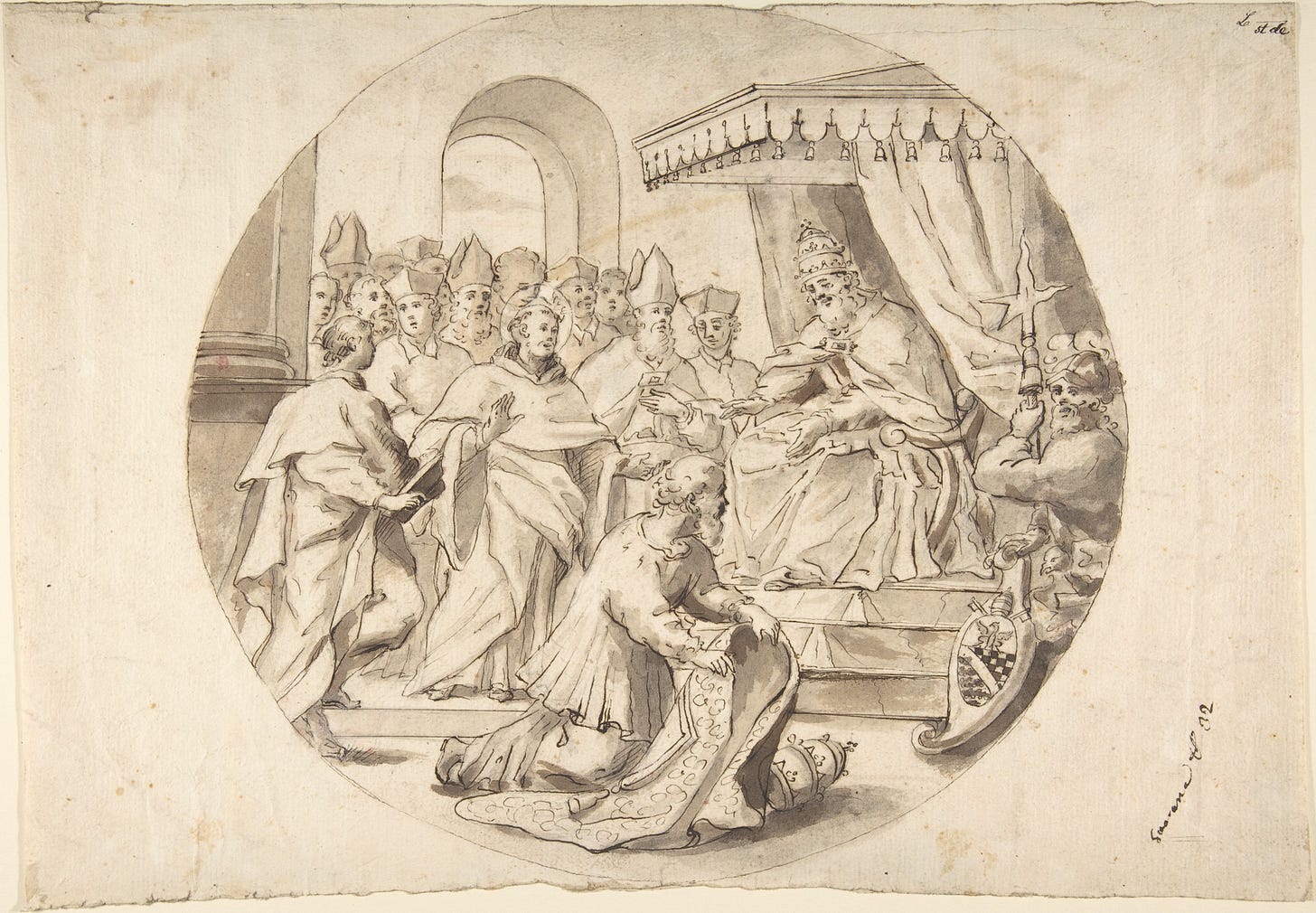
Wisdom from above
I’ve always been struck by a couple of verses from Psalm 16 that I pray every Friday morning (in the office of Prime from the Monastic Diurnal): Ut non loquatur os meum opera hominum: propter verba labiorum tuorum, ego custodivi vias duras. Perfice gressus meos in semitis tuis, ut non moveantur vestigia mea. The psalmist says: “That my mouth may not speak the works of men: for the sake of the words of thy lips, I have kept hard ways. Perfect thou my goings in thy paths: that my footsteps be not moved.”
Our preoccupation should not be with “the works of men” — but our psalmist, very down to earth as he is, is well aware that it is very, very hard for us to resist that fascination. Thus, he immediately adds: “for the sake of the words of thy lips, I have kept the hard ways.” The hard ways are: fidelity to daily prayer; fidelity to daily duty; fidelity to tradition, no matter who or what attacks it; fidelity, in the end, to God, who is the only one whose words are always and absolutely true, and therefore absolutely and always worth paying attention to, reflecting on, and embracing.2 We feast on every word that comes from the mouth of God. The psalmist continues: “Perfect thou my goings in thy paths, that my footsteps not be moved.” As if to say: strengthen my resolve and my ability to walk in the Lord’s way and never be deterred, regardless of what happens in the world of men.
After all, what can we really control? What can we do? What must we do? What will make the biggest difference?
The answer is: cultivating my own vineyard, the vineyard of my soul. Praying. Praying for the pope, for the Church, for the restoration of tradition.
Every day, after Prime, I pray for Pope Leo XIV the following prayer from the good old 1953 Manual of Prayers:
V. Let us pray for our Holy Father, the Pope.
R. The Lord preserve him, and give him life, and make him blessed upon earth, and deliver him not up to the will of his enemies.
Let us pray. O almighty and eternal God, have mercy on Thy servant, Leo, our pope, and direct him according to Thy clemency in the way of everlasting salvation, that he may desire, by Thy grace, those things which are pleasing to Thee, and perform them with all his strength. Through Christ our Lord, Amen.
And then, I turn my mind elsewhere. Having commended the pope to God, I leave him with God, and go about my business here and now.
Or, you may prefer this classic prayer:
Deus, ómnium fidélium pastor et rector, fámulum tuum Leonem, quem pastórem Ecclésiæ tuæ præésse voluísti, propítius réspice: da ei, quaesumus, verbo et exémplo, quibus præest, profícere; ut ad vitam, una cum grege sibi crédito, pervéniat sempitérnam. Per Dominum nostrum.
O God the Pastor and Ruler of all the faithful, look favourably on Thy servant Leo whom Thou hast been pleased to appoint as shepherd of Thy Church: grant, we beseech Thee, that by word and example he may edify those over whom he is placed, so that, with the flock entrusted to him, he may attain unto life everlasting. Through our Lord…
Those feeling more ambitious might like to pray the “Litany of Holy Popes,” in which, across the course of a week, one ends up invoking every canonized pope in the history of the Church. It might be a good thing to do once a year, either at the pope’s anniversary of coronation installation, or around the feast of SS. Peter & Paul in June. Or, if you like to sing, have a look at this.
In short, pray a prayer of that sort; commend the pope to the Blessed Virgin Mary; and be done with it. Do not let yourself be distracted and disturbed by endless reports, warnings, analyses, speculations, prognostications, and suchlike.
What is the solution to hyperpapalism? I suggest it is this: live the Catholic Faith as traditionally as you can. Immerse yourself in its prayers: the Holy Mass, the Divine Office, the Rosary, and other rock-solid devotions. Live by the rhythm of the traditional calendar. Fast and feast. Read your Bible (lectio divina: Catholics were doing it for centuries before Protestants ever arrived on the scene). Teach and hand on the traditional Faith. Try to simplify your life of technological clap-trap. Leave the rest to God.
Some wise words from Robin Phillips:
Throughout the modern West, millions of people are turning to Buddhism to recover peace, stillness, and a slower form of life. What is truly sad is when someone has been driven to exhaustion by the church, only to find in eastern mysticism a slower and more peaceful spiritual experience. This is tragic because Christianity itself offers a path to a more contemplative and leisurely spirituality. But this requires reframing what we think is “God’s work.”
I often think about this when I hear the umpteenth appeal to “outreach,” “mission,” “evangelization,” etc. Why don’t we put our attention first on divine worship and personal prayer, and then see how the Lord Himself multiplies our loaves and fishes? What a revolutionary idea!
Why the Francis-critics are wrong
I see a lot of panic and pessimism about Leo XIV out there among (some) traditionalists because of indications of his continuity of mind with his predecessor and with Vatican II. I think this reaction is a mistake, for a few simple reasons.
1. We were never likely to get a pope who was not, in many respects, in continuity with Francis and the Vatican II mindset. Yes, we might have dreamt of Sarah or Erdo or Pizzaballa, but when you think about it, the progressives had the majority all along; and even a conservative would have paid at least lip service to his predecessor and to the last Council. Regret it all you want, it’s “what they do.”
2. We were never very likely to escape a Boomer pope. However, there’s a huge difference between someone born in 1936 and someone born in 1955. Bergoglio came of age in the delirious ecstasy of Vatican II and was forever stamped by that Woodstock experience. Prevost was only 10 years old when Vatican II ended, and while he too grew up in the post-nuclear wasteland, the relationship to the event was quite different. Let’s put it this way: Bergoglio was emotionally codependent on Vatican II, whereas Prevost is only conceptually committed to it. This is a step on the path to the next pope, who will be not quite as conceptually committed as Prevost, until a time comes when a pope arrives for whom Vatican II is just one among many councils, no more. Yes, it’s a darn slow process, but that’s how human generations work, and we have to remember that instant results are given by computers, not by history.
3. A difference in personality and approach can make a HUGE difference on the ground. There are innumerable indications that Prevost is a vastly different personality than Bergoglio, all in positive ways, and that he does not want to go around making enemies and shooting people down. If we could just get some breathing room for a few years, that would be a win at this stage. Moreover, there’s no doubt that one reason an American was elected was to clean up the Vatican financial disaster: “Surely an American can raise money and fix problems!” But to do this well, you have to stop waging war on conservatives and traditionalists, who have at least some sway over public perception and the flow of donations. A man who’s trying to fix a broken institution is more likely to exercise discretion and welcome different parties to the table.
4. We owe it to any man in high office to pray for him, to give him a chance to lead in that office, to let him make some mistakes (as any fallen human being will do), and to refrain from premature condemnation. This is not naivete or wishful thinking; it’s a matter of justice and charity, what we owe to our fathers at all levels, in the family, in the parish, in the diocese, in the universal Church.
Don’t misunderstand me: I’m not saying we should not call out evils when we must. But must we do that 24/7? Can we not exercise some self-restraint, and pray a Rosary instead of firing off the next barrage? Might we even consider... ignoring the pope for long stretches of time, so that we don’t fall into a subtle papolatry that makes him the be-all and end-all of Catholicism?
Some people who read this will no doubt be tempted to say: “Aha! Then why did you not take your own advice with Francis? You were always criticizing him!” Well, actually, in the first couple of years, I tried very hard NOT to do so, and to point out all the good and orthodox things he said and did (you can read that in the first chapters of my Road from Hyperpapalism to Catholicism, vol. 2). It was only when the errors and wickedness began to cry out to heaven for vengeance that I could no longer keep silent about them; it was time for confrontation and condemnation.
With Leo XIV, we are not even CLOSE to that point, so why don’t we start off with benevolence and beneficence, rather than antagonism? Not to sound like a Buddhist, but why don’t we chill out? Plus, if St. Francis de Sales is right to say that one catches more flies with honey than with vinegar, we might bear in mind that the “look” and “sound” of traditionalists can be of considerable importance in rebuilding the bridges Francis blew up.
Lastly, a reminder to one and all: Not to pray for someone because you think he is hopeless is a form of the sin of despair.
Prayer is real, and the grace it asks for is real. A bad pope can become worse if we fail to pray for him, and a good pope can become still better through our prayers for him. That is why I will never stop asking the Lord to send His grace upon this man who bears the weight of the world on his shoulders.
But what if…?
To reiterate an important point: I’m not saying we should go and bury our heads in the sand, and never, ever pay attention to or comment on what the pope is saying or doing. Obviously, that would be quite absurd. Nor can we pretend, LARPingly, to be those enviable medieval peasants who didn’t know who the pope was in Rome. I agree completely with Leila Marie Lawler when she writes:
I think it’s totally valid to be vocal about our expectations and prayers for a return to normal, orthodox Catholicism. As Pope Leo has already experienced pressure from the progressive wing of the Church and will continue to hear from them, it’s vital that the defenders of Scripture, Tradition, and the perennial Magisterium keep up expressions of exactly what we know is right.
Yes. We should make this defense of the truth, as it pertains to our state in life and our “platform”; we should make our needs respectfully known, insist on our rights when they are trampled. What I’m saying is that we should choose our battles wisely, and not react at every moment to every positive or negative bit of news that floats our way. Hyperpapalism promotes a vicious (and exhausting) cycle of coverage, commentary, and critique.
Anyone who is attacking Pope Leo XIV for not immediately reining in every abuse in the Church, firing every wacko at the Vatican, canceling every silly message for Vesak, or whatever, needs to stop. Now.
He’s been pope for all of one week (!), and while a pope can theoretically do almost anything that concerns the governance of the Church, practically it will take time to tackle the problems. He needs to get to know the ropes, choose his priorities, pick his battles, form alliances, gain traction, and so forth. Not even the most powerful popes in the past got all they wanted, and all the more is this true now, when the Vatican is so bloated, bureaucratic, and torturous.
If you know anything about how a large organization is run, with dozens of departments and hundreds of employees, and with documents or statements planned months in advance, you'll know how little the head of the organization actually controls at any given moment. Obviously, he can flex his muscle when he decides to, but even that decision is fraught with conditions and consequences. The virtue of prudence takes all circumstances into account — and, as Leo XIII taught, it sometimes issues the command that one must tolerate an evil, at least for a time, because one cannot uproot it immediately without causing other worse results.
I am confident Leo XIV is feeling his way forward in the mess that is the Vatican of 2025, and I believe it’s our job to pray for him, to support his good initiatives and statements, and to cut him quite a bit of slack as he settles into this challenging role.
Enough with the criticisms already.
I make Roberto de Mattei’s words my own:
Many are scrambling to reconstruct the acts and words of the bishop and then Cardinal Prevost to understand what the agenda of his pontificate might be. The fear is that the discontinuity with Pope Francis in form is not matched by a similar distance in content. But in an age when praxis prevails over doctrine, the restoration of form already contains, by implication, a restoration of substance. It should also be remembered that, at the time of his election, every pope receives graces of state commensurate with his task, and several times it has happened that a pontiff's position changes once he assumes the Petrine ministry. For this reason, as Cardinal Raymond Leo Burke well said in a statement of his own, assuring his support for the new Pontiff, it is necessary to pray that the Lord will grant him, “abundant wisdom, strength and courage to do all that Our Lord asks of him in these tumultuous times.” To the intercession of Our Lady of Guadalupe recalled by Cardinal Burke, we suggest adding that of Our Lady of Good Counsel venerated in the Augustinian shrine of Genazzano.
Of course, vigilance and struggle against the external and internal enemies of the Church cannot cease, but it is not the hour of disappointment and worry, it is the hour of joy and hope. It is the hour of joy because the Roman Church has elected the Vicar of Christ, Leo XIV, renewing the apostolic chain that binds him to the Apostle Peter. It is the hour of hope because the successor of Peter is the Head, on earth, of the Mystical Body of Christ, which is the Church, and the Church, even amid the trials and persecutions to which she is subjected in history, always rises triumphant, like Her Divine founder.
A traditional priest from the United States shared these words of wisdom:
I do encourage everyone to maintain a supernatural perspective in the days and weeks to come. Let us avoid falling into an unhealthy pessimism that has enslaved so much of the online sphere. Let us be ready to give our Pope a pious and filial respect and loyalty. Let us pray very much for him and for the Church, the Mystical Bride of Our Lord. I, for one, am quite excited to see what Our Lord has planned for the future of his Bride, remembering as always, “that in everything God works for good with those who love him” (Rom 8:28).
Don’t be played
I am surprised at how some trad commentators are letting themselves be easily “played” by a trick that the Left always, always does.
I heard Fr. James Martin interviewed by National Pravda Radio (NPR). He said nothing of any substance with regard to Leo XIV’s actual views, sidestepping difficult questions. Instead, his entire modus operandi was simply to try to put a liberal mantle around the new pope in order to co-opt him for his own agenda, a sort of self-proclaimed imprimatur. We can and will see the same tactic employed by other major progressive figures: they all want to shape the narrative, so that the uneducated world thinks of Leo as a “Francis 2.0” and gets on with its business of destroying, distorting, or ignoring the Catholic faith.
I don’t think it’s going to be that easy for the progs this time around. Smarter commentators are already beginning to realize that Leo is not a Francis 2.0. Yes, there is and will be continuity (surprised?), but there is also a good deal more Catholicism, kindness, and, as far as I can tell, subtlety in Leo than there ever was in Bergoglio.
So, my dear friends, be smart, and don’t let the Jimmy Martins of the world run circles around you and paint you gullible.
Now, I can easily imagine rad-trad critics of mine (for they do exist!) saying: “Ah yes, Dr. K, but aren’t you in danger of being played? You seem a great deal too optimistic for an experienced traditionalist. After all, Leo is a post-Vatican II pope, he fully endorses Vatican II and synodality and immigration and the rest of it, so you should be joining your voice of protest to ours.”
Well, to begin with, I’ve explained elsewhere why I am neither an optimist nor a pessimist, as I think both attitudes are excluded by the Gospel. But to respond more helpfully to the objection, let me just say that I do not have rose-colored glasses on. I concur with New Catholic, the editor of Rorate Caeli:
You may criticize us as much as you want, but we feel an increasingly warming kinship with Leo XIV. There is something unmistakably good about him. He has a good heart. He seems sincerely kind. That is already a huge asset for a bishop, and not as common as it should be.
He will probably (certainly?) disappoint us... It seems this is the way of the world: mistakes, disappointments, and regrets. Sorrow for what was done, and sorrow for what was not done. Fear of doing, and fear of missing out. Anger over wrong turns, and tears over situations that cannot be fixed. It is the wages of the Fall.
May Traditional Catholics give the new pope the love and esteem and respect, and prayers, he deserves. Freely and without fear, and hoping for the best, knowing they might not be reciprocated, and expecting to be disappointed. It seems to be our fate.
May the Virgin protect him, and protect us, and may the Church of Our Lord Jesus Christ and the Traditional Latin Mass and Liturgy grow from strength to strength until the end of time.
That, in a nutshell, is my entire attitude — and I truly believe it is the right one, not only at this moment, but as a default. There is a healthy realism and modesty about it, and most of all, a proper emphasis on the entire Church and her welfare.
Baby and bathwater
A preoccupation with the faults and foibles of a given pope — or even, paradoxically, with his virtues and valor — can have a distorting effect on the pure and sound faith we should have in the office and function of the papacy. By focusing always on the individual as individual, we tend to lose sight of the vicar, the representative, of Christ. I suggest we think of the pope more as an icon and less as a pop star or politico. Allowing our vision to merge with the lens of the media has, I think, an acidic effect on our childlike faith in divine Providence and the promises of Our Lord.
Robert Lazu Kmita reminds us, with many fine testimonies from tradition and against the claims of the Eastern Orthodox, that Catholics have always believed the pope to be the visible head of Christ’s Church on earth:
The Christian faith that is truly orthodox also has an ecclesiological dimension: the belief in the hierarchy instituted by our Savior Christ, which includes, as the visible head of the Church and “servus servorum Dei,” the Supreme Pontiff. My Ancient Greek professor, passionate about Christian sacred symbolism and translator of the writings of St. Dionysius the Areopagite, taught us that the hierarchy existing in the Kingdom of Heaven—whose head is God Himself—is mirrored by the ecclesiastical hierarchy of the Militant Church—whose visible head is the pope.
Having said this, Kmita also shows that it is possible, nay, crucial, to be a “papist” without being a hyperpapalist.
For reasons well explained by Fr. Matthew Solomon, Pope Francis has — for those with eyes to see and ears to hear — forever driven the nails into the coffin of hyperpapalism. I am glad for it.
Cheer up, mates!
Sometimes on Fridays I run a “good news” section. There is plenty of good news right now, and I think a lot of it, frankly, is connected to the positive energy of the new pontificate. Good people are emerging from hiding; the dictatorship is past and we can breathe more easily.
Thus, for example, on May 8, a solemn TLM was offered in the Basilica of Santa Maria Maggiore, only steps away from the tomb of Francis, by clergy of the Institute of Christ the King Sovereign Priest. The church was crowded and the Mass was glorious. The TLM had been banned from this basilica under Francis.
Prompted by Leo’s frequent chanting of prayers in Latin (“more of this, please,” as Kennedy Hall remarked), the Pontifical Institute of Sacred Music (PIMS) has launched an initiative called “Let’s sing with the Pope,” providing videos for learning basic Gregorian chants. PIMS would not have launched this under Francis, but now they’ve done it not even a week after Leo’s election. As if they were waiting for the right opportunity.
Lo and behold, I think Leo XIV himself is providing some good teaching and good examples of papal modesty — and fortitude.
In a quotation that has gone viral, Leo said to representatives of all 23 Eastern Catholic Churches:
The Church needs you. The contribution that the Christian East can offer us today is immense! We have great need to recover the sense of mystery that remains alive in your liturgies, liturgies that engage the human person in his or her entirety, that sing of the beauty of salvation and evoke a sense of wonder at how God’s majesty embraces our human frailty! It is likewise important to rediscover, especially in the Christian West, a sense of the primacy of God, the importance of mystagogy and the values so typical of Eastern spirituality: constant intercession, penance, fasting, and weeping for one’s own sins and for those of all humanity (penthos)! It is vital, then, that you preserve your traditions without attenuating them, for the sake perhaps of practicality or convenience, lest they be corrupted by the mentality of consumerism and utilitarianism.
The implications of this statement are staggering. I hardly need to draw them out. Western traditionalists have been living by our unattenuated, beautiful, majestic, authentic Roman Rite for decades. If Leo is a man of logic, he has already made the connection.
Just today, Leo spoke words to the Diplomatic Corps that would be unimaginable on the lips of his predecessor:
For her part, the Church can never be exempted from speaking the truth about humanity and the world, resorting whenever necessary to blunt language that may initially create misunderstanding. Yet truth can never be separated from charity, which always has at its root a concern for the life and well-being of every man and woman. Furthermore, from the Christian perspective, truth is not the affirmation of abstract and disembodied principles, but an encounter with the person of Christ himself, alive in the midst of the community of believers. Truth, then, does not create division, but rather enables us to confront all the more resolutely the challenges of our time, such as migration, the ethical use of artificial intelligence and the protection of our beloved planet Earth. These are challenges that require commitment and cooperation on the part of all, since no one can think of facing them alone.
Other examples could be given. As José Antonio Ureta explains, already in a single week Leo XIV has given many indications of how different his approach will be from Francis’s, in spite of the continuities that could be expected.
Be of good cheer, then, and let’s give Leo a chance — and most of all, let’s reorient our perspective, recenter our attention, on things eternal and things immediately in front of us. And when I say “immediately in front of us,” I mean, in flesh-and-blood reality. Things that pop up on our social media feed are not really present to us, in spite of the illusion that they are. (By the way, Clement Harrold’s article at First Things, “How I Kicked My Smartphone Habit,” is well worth a read, as is “On the Death of Daydreaming” by Christine Rosen.)
The grand upshot
I say all the above because, while I will continue to share in my Weekly Roundup the best articles I’ve read each week, and while that harvest will almost inevitably include some pieces about the pope, I intend Tradition & Sanity in its third year (Laus Deo et Mariae) to move forward in covering a wide range of topics of interest to tradition-loving Catholics, and to let the papacy fall into its modest place among them. In keeping with Aristotle’s advice, we hope, in fact, to bend the stick in the opposite direction, so that we might hit the mean.
Already, we have published guest contributions by Sebastian Morello and Angela Cuba. We have a fantastic two-part series on the traditional Roman rite of marriage by Anthony Jones coming the next two Thursdays, and Julian Kwasniewski on American folk music after that. Joseph Shaw and Fr Thomas Crean will soon be ready with their inaugural posts. I have a lot planned for you over the rest of 2025. It’s an exciting time!
(While I’m talking about the Substack: THANK YOU, dear readers, for a tremendous response to the Second Anniversary subscription drive that took place from May 1-9. The flood of new subscriptions pushed Tradition & Sanity ahead from #22 to #20 worldwide in the Faith & Spirituality category. A few wild-eyed apocalyptic Protestants, chilled-out Buddhists, and let-no-evidence-dissuade-us feminists are still ahead of us, alas, but we are making an awfully good showing for a movement in the Catholic Church that is commonly shrugged off in the media as “merely 1% of the faithful.” This 1% sure knows how to shake things up…)
Thanks again for being faithful readers. I offer my share in the Holy Sacrifice of the Mass every Thursday for your intentions.
Update on Dr. K’s Work
At New Liturgical Movement, the gloves are off in my article this past week, “Driving on Liturgical Interstate 80”:
The full season from pre-Lent to Pentecost Octave is where you see the old Missal shine most brilliantly. Everything fits together so well, so tightly, made up of inevitable steps; one finds a profusion of variety, a strength of biblical fidelity, an intricate drama of mysteries fully plumbed but also subtly integrated one with another, so that all is well ordered and proportioned.
The reformers who dared to change all this (and, indeed, they left hardly a stone upon a stone) were acting from their extremely limited postwar academic perspective, and the result is, predictably, superficial—clean, obvious, and sterile; you get the sort of workmanlike coverage that might be expected in a diligently prepared government report. It is like a relationship from which romance has been sucked dry, or, more accurately, in which it never had a part.
The week before at NLM, I wrote a manifesto called “Why the Traditional Mass Should Remain in Latin.” The problem:
Due to the way the internet encourages the spontaneous expression of feelings and ideas (or some mixture of the two), a lot of premature and undercooked opinions tend to be expressed. One of the most frequent proposals I see being floated is this one: “Wouldn’t it be just grand if we could have the TLM in the vernacular? This would kill two birds with one stone: We get the traditional liturgy, but without the language barrier! Everyone would flock to it and the breach between old and new could be healed at last!”
I offer multiple arguments as to why this is a bad idea, and would harm the Roman Rite in a way comparable to the removal of icons from a Byzantine church. Read the whole thing here.
Os Justi Press has become an official distributor for a very important work of theology: St. John Fisher’s magnum opus, The Reality of the Body and Blood of Christ in the Eucharist. In this mighty treatise aimed at the Protestants of his day (and ours), Fisher, armed with mastery of Scripture, Church Fathers, and logical argumentation, shreds the case against Transubstantiation and confirms the Church's perennial faith. This bilingual (Latin/English) privately printed gorgeous hardcover edition is graced with numerous plates, a theological and historical introduction, and an appendix on Patristics.
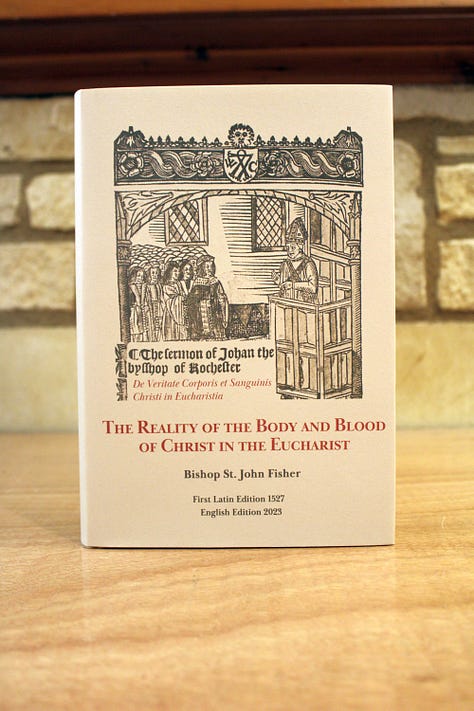
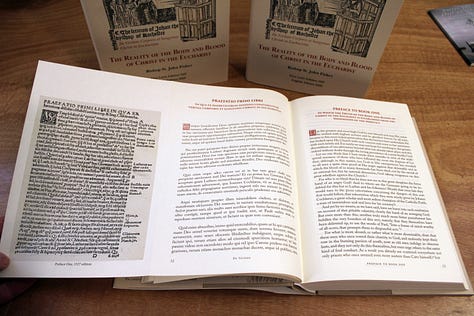
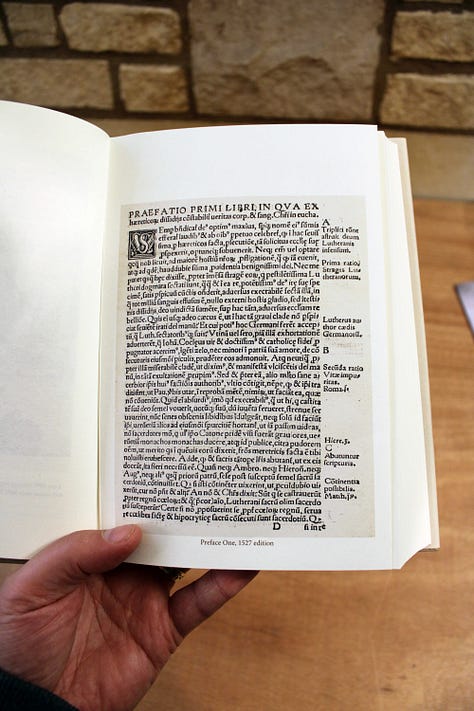

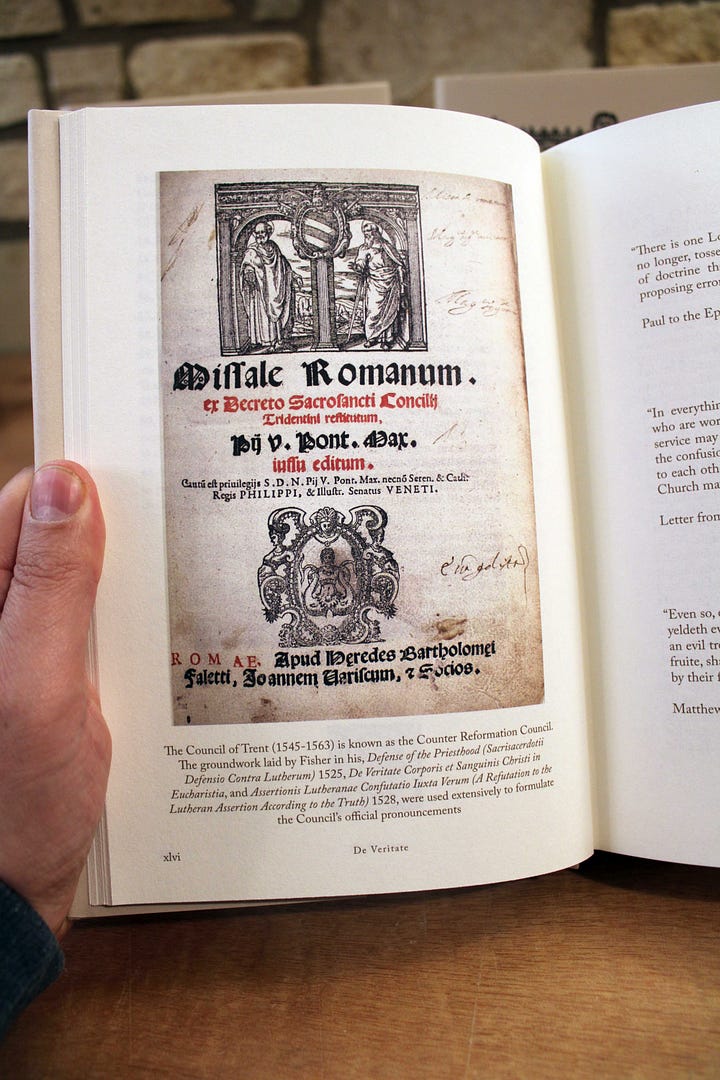

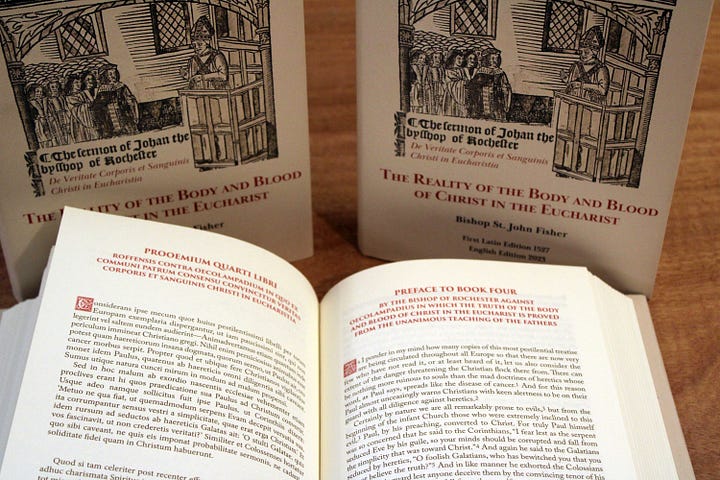
If synodality is all about “walking together” and “listening,” why not ACTUALLY walk together on a pilgrimage, sharing, singing, and suffering? The tens of thousands of Catholics who will tread the pilgrim paths to Chartres, Covadonga, Walsingham, Auriesville, Clear Creek, etc., are being more synodal than all the delegates buried under reams of paperwork sitting around tables.
This July, I’ll be doing the Covadonga pilgrimage in northern Spain (more details here — I’ll be with the St. Kateri Chapter from North America, you can contact Jeff Inferrera to sign up). Would love to spend time with any T&S reader who decides to join us! I will also be giving lectures in six cities, Deo volente — Seville, Cordoba, Toledo, Madrid, Segovia, and Oviedo. Stay posted for more details.
Incidentally, if anyone is interested in seeing where I’ve given lectures in defense of Catholic tradition over the past decade or so, here are a few maps (North America, Europe, and eastern Australia):



Roundup of favorite articles
Not having done a roundup since May 2, I’ve got a huge list of favorite articles to share with you. I will try to be super-selective, in order to keep this post from rambling on to an impossible length.
In the past, I’ve had words of sharp criticism for Brant Pitre when he moved out of his element. But here, in an illuminating study of the link between the Temple altar and the Christian altar, we see Pitre at his very best: “The Jewish Roots of the Catholic Altar: The Bronze Altar (Part I).”
Worth a look and a read: the latest issue of Gregorius Magnus, the online magazine of the International Una Voce Federation. Read online here; download a high-definition PDF here.
Those interested in a short Gregorian chant workshop for all skill levels may want to check out this opportunity in Detroit, June 27-29.
Liturgical Arts Journal continues to inspire us with “Before & After” comparisons (here’s another) of ugly or plain churches transformed into majestic temples of God. The season of iconoclasm seems (mostly) over, and a season of iconophilia is opening before us.
Amelia McKee, “Mary, Gardens, and May”
Joshua Charles, “The Judas Within: The Church Fathers on Enduring Evil in the One True Church” (video)
Here’s the sad story of a parish in Indiana that was experiencing a rebirth thanks to the arrival of the ICKSP, which brought people and money to the place… until the resident Boomers complained to the media, a hit piece was published, and the bishop moved the ICKSP away. Now, a few years later, the parish is being shut down, with lots of hand-wringing.
You know, it isn’t rocket science.
And here’s the story of what a particular parish suffered thanks to Pope Francis, a murderer of Catholic vitality.
Eric Sammons has written an excellent article on AI (though I prefer to call it SI, “simulated intelligence”) and the proper Catholic response to it: “The Catholic Artificial Intelligence Moment.”
Aaron Pattee: “The image of opulent nobles and wailing serfs bound only by their shared, bleak prospects of dying at a young age dominates modern conversations of medieval health. There is a presumption that medieval folk rarely crest the age of 40, and that anyone over that watershed year was necessarily regarded as an ancient.” An assumption that turns out to be false — as usual.
Looking for a good cause to send a tithe to? I know people on the inside of Campos — a quasi-diocese in Brazil that uses exclusively the traditional Roman Rite, the only one of its kind in the world — and this very faithful but materially very poor body of Catholics needs help for their apostolates and vocations.
Emily Finley, in “Simplified Liturgical Living,” reflects on why the huge market for “liturgical living” books, products, and craft-ideas is largely driven by anemic baseline liturgy — and how the TLM is the key to reversing the lack of Catholic culture, but in an organic way that energizes rather than depletes.
For those who’d like a deeper understanding of the Augustinian-Thomist concept of “ordo amoris” or the right ordering of our loves, check out this Josias podcast.
Robert Keim reminds us that “The First Pope Leo Saved Rome from the Barbarians” and asks if the fourteenth will do the same.
Freya India, in “The Right Has Forgotten Feeling,” explains why conservatives, especially Catholic men, need to find a very different way of speaking to and acting in regard to confused and damaged young women if they wish to bring them to Christ.
Michael Foley continues his walk-through of the Latin prayers of the Ordinary of Mass with the Lavabo and the Suscipe Sancte Pater: “The Suscipe Sancte Pater is a remarkably succinct and eloquent summary of the theology of Eucharistic sacrifice. The Mass re-presents not the Last Supper but the Paschal Mystery, the Passion [and Death], Resurrection, and Ascension of our Lord Jesus Christ. The latter event, which brings the fruits of the Resurrection into Heaven, is often overlooked as an integral part of the Paschal Mystery.”
In “Lex Orandi, Lex Credendi: The Rules for Worship Are the Rules for Faith,” Henry von Blumenthal has written a thoughtful overview of the characteristics that most distinguish the TLM from its attempted replacement, and how that replacement is characterized by Protestant-inflected changes: 1. The Sense of the Numinous; 2. Contemplation and Silence; 3. The Witness to Transubstantiation; 4. Sacrifice and Temple Theology; 5. The Recognition of the Communion of Saints; 6. The Powers and Holiness of the Priesthood. The article concludes with a handy table (but not a Cranmer table).
Greg Schlueter, “Our Church at the Crossroads of Eternity”: “How we regard the unborn, the most defenseless among us, reveals how we regard God Himself. It unveils whether we are aligned with the Author of Life—or with the ancient Enemy, the one who, from the beginning, sought to mar and murder the image of God in man.”
Robert Lazu Kmita, “Icons: Sacred Images”: “If the hieratic and sacred beauty of Christian images and holy objects disappears from our churches under the influence of the new iconoclasm, let us not be surprised that, frozen, the souls of the faithful will long for the worldly spirit, ultimately losing their supernatural faith. Without sacred art, authentic religion—like a flower—fades, withers, and dies. This is why the sign of the restoration of authentic Catholic religion can only be the restoration of authentic sacred art.”
Henry Sire is a remarkable man. His book Phoenix from the Ashes is one of the best histories of modern Catholicism I’ve ever read. He recently did two interviews, one in writing (“Francis’s Legacy and the Path Forward”) and one on video with Matt Gaspers.
Fr. Peter Stravinskas has offered us a wonderful synopsis of the reason why Catholics should receive Communion on the tongue and kneeling. His response draws on all the best material available (some of it not footnoted, it’s true — he nearly quotes me verbatim — but that’s hardly important).
“Catch us the little foxes that destroy the vines…”
Life is suburbia isn’t so bad when a fox decides to come and take a nap in your back yard. I knew there was a good reason for delaying the lawn mowing. And since we have no vineyard, the fox can’t do what the Canticle of Canticles warns against (see Cant. 2:15).


Thanks for reading and may God bless you!
I’m reminded of this comment by Eastern Catholic Dominic Cassella: “While often presented as a return to the conciliar and collegial life of the early Church, synodality as it has unfolded under Francis has been ambiguous in both purpose and effect. And it risks becoming less about recovering the authentic structures of communion and more about introducing a managerial ethos into the life of the Church. The talk of listening sessions, consultations, and processes, on the face of it, resembles bureaucratic meaninglessnes, in contrast to a synodality of hierarchy and tradition.”
If a council or a pope defines a dogma or anathematizes an error, then they are speaking with divine authority, and thus this word is also inerrantly true. Still, it is so derivatively, and not of itself, whereas God’s word is true of itself.





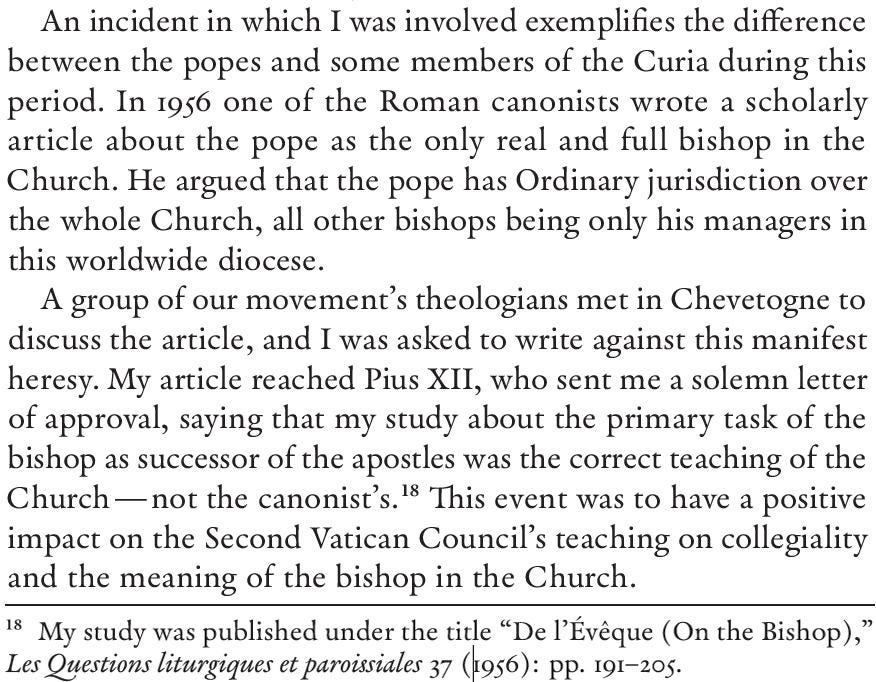


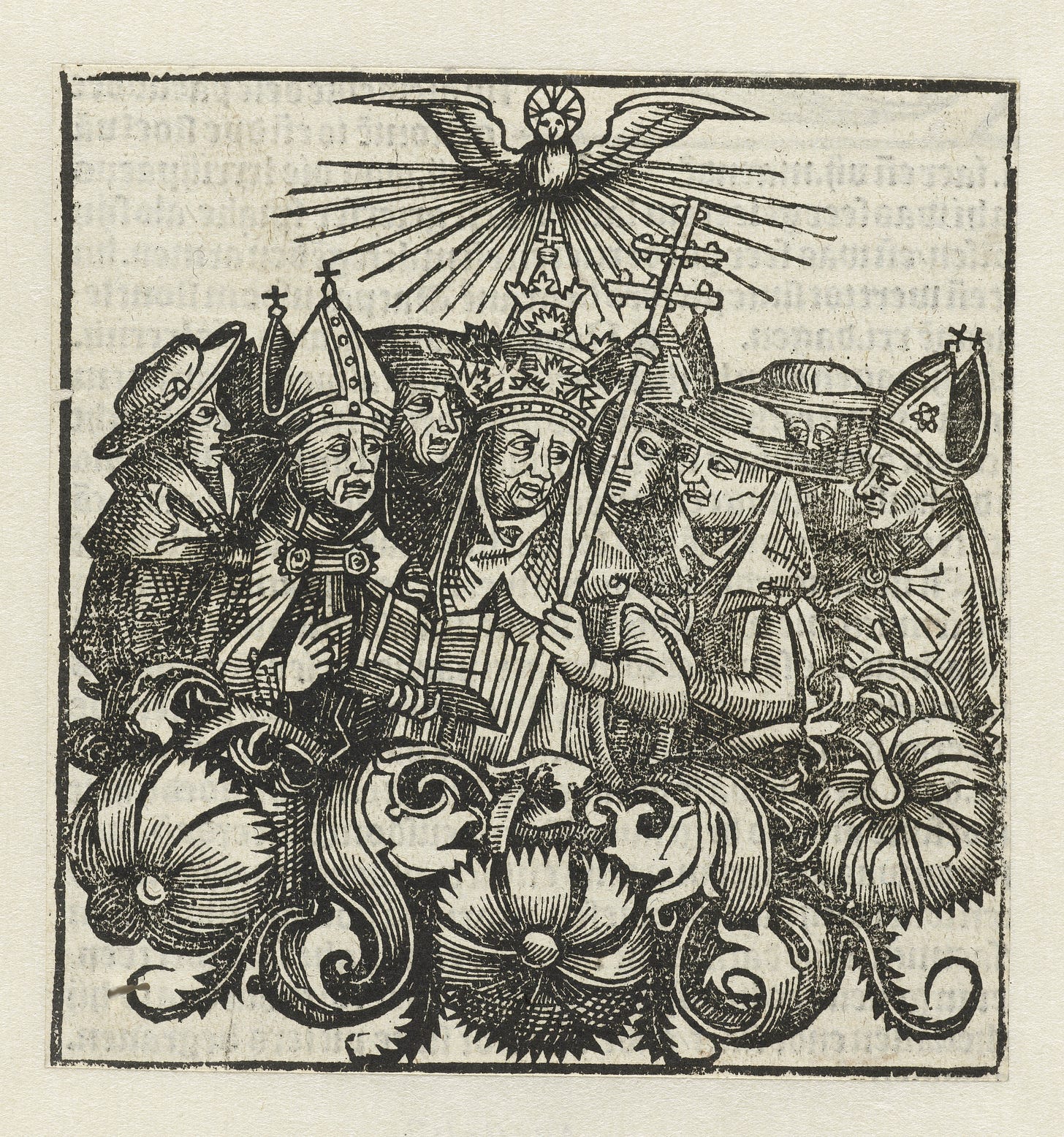

This is an excellent reminder that the Church is not a media brand, and the pope is not its CEO. But it’s more than that. Hyperpapalism isn’t just a distortion of ecclesiology, it’s a distortion of incarnation. We begin to think grace descends through press conferences, that holiness can be tracked in policy shifts, that renewal must be managerial before it can be mystical.
But God didn’t wait for good governance to redeem the world. He came into a world where Caesar ruled and Herod schemed, and He changed it not by issuing decrees but by inhabiting flesh. If Christ chose to sanctify the world through a body, not through a bureaucracy, then the way forward for the Church is not to scrutinize Rome’s gestures like omens, but to tend to the places where Christ is still taking on flesh… the altar, the neighbor, the wound, the word whispered in prayer.
The danger of hyperpapalism is not just that it exhausts us, but that it subtly trains us to look for transcendence in abstraction rather than in the present moment. And the enemy is pleased to have us watch the sky for signs while God passes by in the face we’re too distracted to see.
Pray for the pope, yes, but let’s remember: the mystical Body is incarnate in the person beside us, not just the person in white.
I've come up with a shorter word for Dehyperpapalization: Catholic.